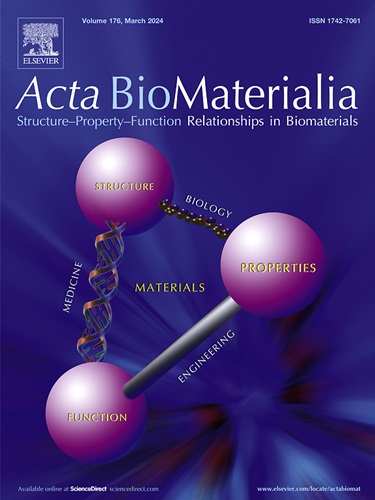包封天然传感器激动剂的聚酸酐纳米颗粒可激活小鼠上皮细胞和气道细胞,减少呼吸道合胞病毒感染。
IF 9.6
1区 医学
Q1 ENGINEERING, BIOMEDICAL
引用次数: 0
摘要
急性呼吸道感染(ARTI)是全世界婴儿发病和死亡的主要原因。考虑到抗菌素耐药性作为全球威胁的出现,人们对预防呼吸道感染的免疫调节策略越来越感兴趣。由于ARTIs是由几种病原体引起的,旨在参与先天反应的免疫调节策略代表了预防ARTIs的有希望的策略。本研究开发了由聚酸酐共聚物和模式识别受体(PRR)激动剂组合而成的先天刺激纳米颗粒(NPs),通过激活粘膜水平的先天机制来增强疾病抵抗力。对人和牛呼吸道上皮细胞的体外分析表明,装载传感器激动剂的天然NPs可触发炎症、抗病毒和抗菌介质的转录。此外,NPs预处理可降低体外感染人、牛呼吸道病毒(RSV)的滴度。小鼠鼻内给药含有prr的多酸酐NPs导致肺部短暂产生细胞因子和趋化因子,提示免疫激活。NPs的免疫原性和抗病毒特性依赖于NPs内的聚酸酐共聚物化学和天然激动剂。预防性给药含有TLR2/1、TLR4或TLR2/7激动剂的NPs可降低RSV发病率和病毒肺负荷。选定的NPs在感染前14天施用时也显示出保护作用。这些结果表明,NPs在体外有效地激活人和牛呼吸道上皮细胞,触发抗病毒防御,并减少小鼠RSV疾病。意义声明:我们的研究重点是使用聚酸酐纳米颗粒(NPs)包裹先天传感器激动剂来激活上皮细胞和气道细胞。这种创新的方法利用纳米技术的独特特性来利用先天免疫系统的潜力,提供对多种病原体的广泛抗性。我们设计了一组含有不同化学成分的PRR激动剂的多酸酐NPs,并研究了它们作为呼吸道先天免疫调节剂的有效性。我们证明NPs激活气道上皮细胞的保护性先天免疫反应,并在体外降低RSV感染滴度。np处理的小鼠显示出对rsv诱导的发病率的保护作用,并降低了病毒载量。这些发现突出了多酸酐NPs作为预防人类和牲畜呼吸道病毒的多功能平台的潜力。本文章由计算机程序翻译,如有差异,请以英文原文为准。

Polyanhydride nanoparticles encapsulating innate sensor agonists activate epithelial and airway cells and reduce Respiratory Syncytial Virus infection in mice
Acute respiratory tract infections (ARTI) are a leading cause of morbidity and mortality in infants worldwide. Considering the emergence of antimicrobial resistance as a global threat, there is increasing interest in immunomodulatory strategies to prevent respiratory infections. Since ARTIs are caused by several pathogens, immunomodulatory strategies aiming to engage innate responses represent a promising strategy to prevent ARTIs. Here, innate-stimulating nanoparticles (NPs) synthesized from combinations of polyanhydride copolymers and pattern recognition receptor (PRR) agonists were developed to increase disease resistance by activating innate mechanisms at the mucosal level. In vitro analysis on human and bovine respiratory epithelial cells showed that innate-sensor agonist-loaded NPs triggered transcription of inflammatory, antiviral, and antimicrobial mediators. Moreover, pre-treatment with NPs reduced human and bovine orthopneumovirus (RSV) infectious titers in vitro. Intranasal administration of PRR-containing polyanhydride NPs to mice led to transient production of cytokines and chemokines in lungs, suggesting immune activation. The immunogenicity and antiviral properties of NPs were dependent on both polyanhydride copolymer chemistry and the innate agonist encapsulated within the NPs. Prophylactic administration of NPs containing either TLR2/1, TLR4, or TLR2/7 agonists resulted in reduced RSV morbidity and viral lung loads. Selected NPs also showed protective effects when administered 14 days before infection. These results indicate that NPs efficiently prime human and bovine respiratory tract epithelial cells and trigger antiviral defenses in vitro and reduce RSV disease in mice.
Statement of significance
Our research focuses on the use of polyanhydride nanoparticles (NPs) encapsulating innate sensor agonists to activate epithelial and airway cells. This innovative approach leverages the unique properties of nanotechnology to harness the innate immune system’s potential, providing broad resistance against multiple pathogens. We designed a panel of PRR agonist-loaded polyanhydride NPs with varying chemistries and investigated their effectiveness as innate immunomodulators in the respiratory tract. We demonstrate that NPs activate protective innate immune responses in airway epithelial cells and reduce RSV infectious titers in vitro. NP-treated mice showed protection against RSV-induced morbidity and had reduced viral loads. These findings highlight the potential of polyanhydride NPs as a versatile platform for prophylactic intervention against respiratory viruses in both humans and livestock.
求助全文
通过发布文献求助,成功后即可免费获取论文全文。
去求助
来源期刊

Acta Biomaterialia
工程技术-材料科学:生物材料
CiteScore
16.80
自引率
3.10%
发文量
776
审稿时长
30 days
期刊介绍:
Acta Biomaterialia is a monthly peer-reviewed scientific journal published by Elsevier. The journal was established in January 2005. The editor-in-chief is W.R. Wagner (University of Pittsburgh). The journal covers research in biomaterials science, including the interrelationship of biomaterial structure and function from macroscale to nanoscale. Topical coverage includes biomedical and biocompatible materials.
 求助内容:
求助内容: 应助结果提醒方式:
应助结果提醒方式:


